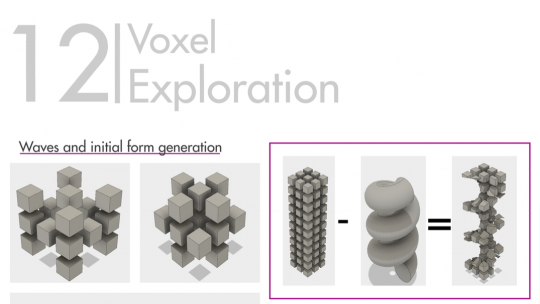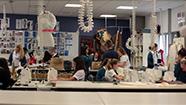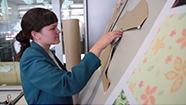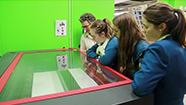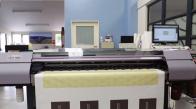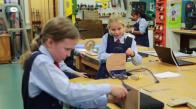Top scholar DVC: A train station

A new transport hub
Christopher Dirks, a year 11 student, designed a new train station for the suburb of Meadowbank in Auckland.
The station design offered a central-east transport hub with a better connection to surrounding transport.
Coming up with the brief
 Designing the brief
Designing the brief

For his scholarship project at the end of year 10, Christopher Dirks chose to do a redesign of the Meadowbank train station. He had an interest in trains and knew this project would challenge him and require innovation.
The current station is under-connected to the surrounding transport infrastructure so the redesign would need to create a central–east transport hub.
The design for the central-east transport hub had to:
- respond to the identity of the surrounding area, including the historical aspects of the suburb
- be located within 750 metres of the current Meadowbank train station while also considering its location (sun, wind, views, access).
Research and ideation
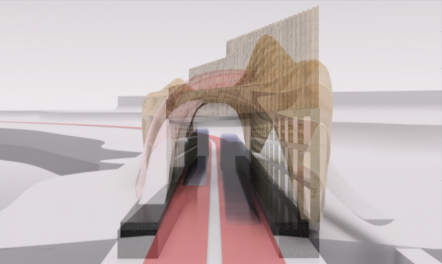
Select the image to view at full size.
Christopher used the Auckland Council website to explore the history of the area and the development of the train station over time. The website has the requirements for building a train station, topographic maps, and aerial photos showing the geography and history of the area.
He used architecture and design books at school to get ideas for his work. He also got inspiration from the surrounding landscapes such as the Orakei basin volcano and its associated rock forms.
Christopher based the shape of his final design on the shape of the Purewa tunnel that was made by brute force engineering in 1926.
"... to include more of a volcanic aspect to the building I have increased the height of the building to create more of a volcanic styling."
Christopher Dirks
Digital fluency
Developing digital fluency
Students who are digitally fluent can use a variety of digital technologies to inform their design thinking and visually convey ideas to produce their desired outcome. Teacher Motu Samaeli says that Christopher’s digital fluency enhanced his project and was one of the key factors in the success of his top scholar submission.
Christopher had access to and experience with a range of tools. In year 5, Christopher’ started to use Google Sketchup on a desktop computer at home and he used this to start designing. In year 9, he was given access to a laser cutter and 3D printer at school and he began to realise some of his design projects including eco-houses and upgrading the 3D printers themselves.
You can see some of these designs on Christopher’s website.
Digital tools for this project
Christopher came across the concept of voxels when researching the format of files for 3D software. A voxel is a value that shows how everything can be broken down into 3D cubes, similar to pixels, with a closer match to a computer screen.
Voxels provided Christopher with an aesthetic base for exploring shape, form, and structure throughout the project. Christopher printed a 3D model of his train station design, but all of the designs in the portfolio are digitally generated.
Christopher had also learnt to use Fusion 360. Fusion 360 is a computer-aided design, modelling, and product design tool. It allows for designing, testing, and fabricating in a single tool.
Fusion 360’s free body design environment was important in creating the final design of the train station. Christopher liked the way that the package deals with shapes as a set of instructions on a timeline because this feature makes it easy to iterate quickly.
Portfolio design story
Convincing communication is one of the performance standards for DVC scholarship.
Convincing communication involves the use of highly refined visual communication techniques and applying outstanding presentation techniques and principles employed in an innovative and coherent manner with visual impact.

Motu said that he never had any concerns with Christopher’s ability to deal with the functionality of the design and offered lots of encouragement to extend the aesthetics of the design.
Motu believes that the quality of the design story contributed to this outstanding scholarship.
It was memorable to hear Christopher say one day, “I didn't realise I was that creative.”
Developing the design story

All of the design development was stored on Christopher’s laptop so that he could edit it easily. On multiple occasions throughout the year, he printed out the design development pages. He lay the pages out in the corridor or across desks to critique and re-order them so that by the end of the year he had an effective visual story of his design thinking.
Christopher's ideas and approach changed as he became more proficient with software. He believes that there were approximately 70 iterations of the project before the final submission.
Christopher said that he enjoyed not knowing what the final outcome would be like. The portfolio format was unique in that it was printed in eight sections and then attached together so it could be read as one long script.
Christopher took all of the photographs of the existing train station and the surrounding environment that are displayed in his portfolio. These photographs enhanced the quality of the design story.
Both Motu and Christopher saw the development of this project as a collaboration between the teacher and the student. It is a great example of a student being captivated by an idea and a local curriculum – where learning is personalised, inclusive, and takes into account the students' aspirations, interests, identity, language, and culture.
Related videos
A technology department with a digital and design focus (04:13)
Julie Clement shares how a design focus has engaged her students.
Resourcing for a digital and design focus (03:18)
Julie Clement considers how resources influence the authentic experiences for her students.
Fab Lab and Wellington Girls' College (04:14)
Wellington Girls' College connects with Fab Lab at Massey University.
Outsourcing digital fabric printing (04:04)
A year 13 class connects with a fabric printing company to outsource their printing.
Engaging contexts in product design (03:09)
Abby Dingle discusses materials and tools that engage students in product design.


